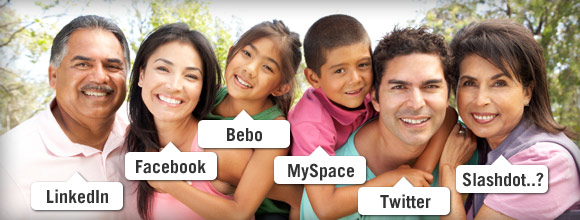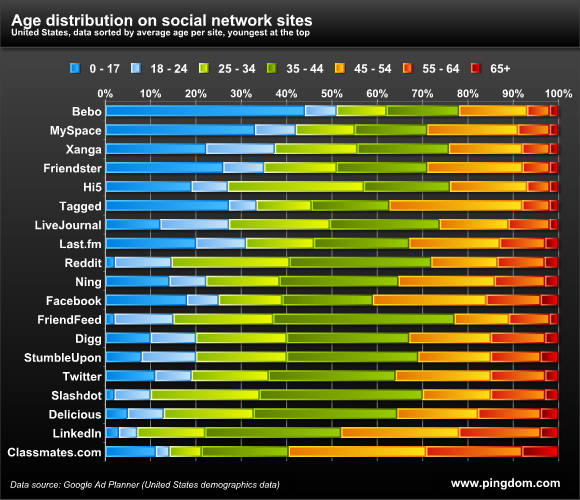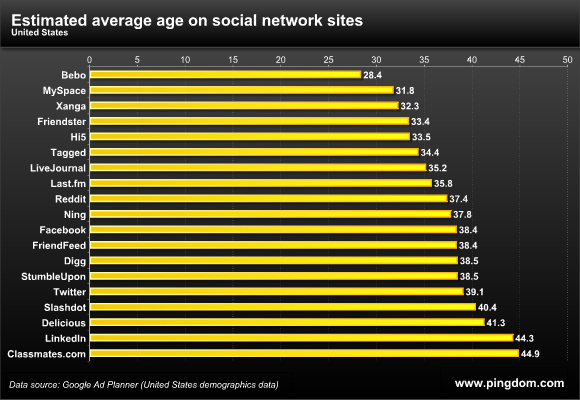
Demographics are distributed within all social networks, but only concentrated within a select few. Where specific demographics materialize varies from network to network and as such, the more effective social strategies and tactics are designed to reach target audiences where, when and how they engage.
Over the years, I’ve relied on Google Ad Planner to surface the critical demographics in order to construct meaningful and targeted social programming. Pingdom recently examined the data and packaged the results in a visually rich presentation worthy of sharing.
The study included 19 social networks…
Bebo
Classmates.com
Delicious
Digg
FriendFeed
Friendster
Hi5
Last.fm
LiveJournal
MySpace
Ning
Slashdot
StumbleUpon
Tagged
Xanga
Age Distribution

The disposition of age groups within social networking as a whole is representative of the state of social media engagement, but this is fleeting. Age groups will only continue to meander as online networking becomes pervasive. At the moment, we can see that those 35-44 dominate the social web, representing 25% of total participation. For those who have actively monitored adoption of social networks, this next stat might not come as a surprise, but it’s worth highlighting nonetheless. Following at 19% isn’t a younger generation at all, in fact, those 45-54 are the second most active group within social networks, just ahead of the 25-34 segment at 18%. Individuals under 17 rank fourth with 15%. I find it fascinating that the 45 to 65+ group, those who are usually considered laggards in the technology adoption cycle, symbolize almost one-third of total users of social networks. They’re equally connecting with not only each other but also the younger generations who are spending an increasing amount of time online as well.

Distribution of Age Within Social Networks
Reviewing the age groups broadly across social media serves only as a primer to the deeper level of analysis required to identify exactly where we need to connect with target demographics. As such, Pingdom performed the first level of segmentation to showcase how age groups are distributed within each specific social network.
Bebo - Over 40% are 17 and under followed by 35-44 and 55-64 at just under 15% each
Classmates.com - The 45-54 dominate at just over 30% followed by 20% at 55-64 and just under 10% at 65+ (Represents the highest concentration of the older demographics with 78% over 35)
Delicious - Over 25% of users are 35-44
Digg – 35-44 constitute over 25% of the total user base followed by just under 20% at 25-34 (80% of users are over 25)
Facebook - ~25% of users are 45-54 with the 35-44 group at just 20% (61% are 35 or older)
FriendFeed – Shy of 40%, 35-44 represent the majority of users
Friendster - Polar opposites with 25% under 17 and roughly 20% 45-54
Hi5 - 25-34 collectively represent close to 30% of all users
Last.fm – Almost 20% are under 17 with the 35-44 category also representing just under 20%
LinkedIn – Less than 30% are 35-44, 20% are 45-54 and more than 15% are 55-64
LiveJournal -25-34 and 35-44 are tied at 20+% percent each
MySpace - Over 30% of all users are under 17 and slightly less than 20% are 45-54
Ning – 25% of 35-44 and over 60% are 35 and older
Reddit - 30% are 35-44
Slashdot – More than 30% are 35-44
StumbleUpon – The 35-44 segment symbolize just under 30% of all users followed by 25-34 at just under 20%
Twitter – More than 25% of users are 35-44, trailed by the 45-54 group at less than 20% (65% of all users are over the age of 35 with less than 20% representing the 24 and under age groups)
Tagged - Almost 30% are 45-54 and slightly over 25% are under 17
Xanga – Over 20% are under 17
Governing Age Groups
If we further review the data, we can see which age groups are dominant across the social Web
17 and under: 21%
18-24: 0%
25-34: 5%
35-44: 58%
45-54: 16%
55-64: 0%
65 and over: 0%
Average User Age by Network
Cascading further down stream, the data when crunched, reveals the average age per network, which allows businesses to better understand the general user within each.
Bebo – 28.4
Classmates.com – 44.9
Delicious – 41.3
Digg – 38.5
Facebook - 38.4
FriendFeed - 38.4
Friendster – 33.4
Hi5 – 33.5
Last.fm – 35.8
LinkedIn – 44.3
LiveJournal – 35.2
MySpace – 31.8
Ning – 37.8
Reddit – 37.4
Slashdot – 40.4
StumbleUpon – 38.5
Twitter – 39.1
Tagged – 34.4
Xanga - 32.3
In social media, not only do women rule, but it seems that the middle-aged are Social Media’s largest share holders. Again, the average number is just that, a generalization of users classified by age, not by usage, theme, or connectivity. As we identify whom it is we need to reach and why, analyzing data as it relates to age groups is just one side of a multi-faceted program. In order to possess and convey value and meaning, it is anthropology, sociology and the psychographic mapping of people to themes, interests, and aspirations that will prevail now and over time. It’s the difference between visibility and presence, and in social media, presence is felt.